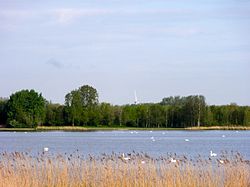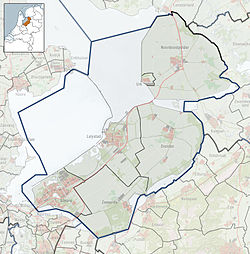
West Low German, also known as Low Saxon is a group of Low German dialects spoken in parts of the Netherlands, northwestern Germany and southern Denmark. It is one of two groups of mutually intelligible dialects, the other being East Low German dialects. A 2005 study found that there were approximately 1.8 million "daily speakers" of Low Saxon in the Netherlands. 53% spoke Low Saxon or Low Saxon and Dutch at home and 71% could speak it. According to another study the percentage of speakers among parents dropped from 34% in 1995 to 15% in 2011. The percentage of speakers among their children dropped from 8% to 2% in the same period.
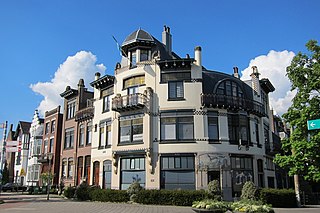
Arnhem is a city and municipality situated in the eastern part of the Netherlands. It is the capital of the province of Gelderland and located on both banks of the rivers Nederrijn and Sint-Jansbeek, which was the source of the city's development. Arnhem had a population of 159,265 in 2019 and is one of the larger cities of the Netherlands. The municipality is part of the Arnhem–Nijmegen metropolitan area which has a combined 736,500 inhabitants.

Overijssel is a province of the Netherlands located in the eastern part of the country. The province's name translates to "across the IJssel", from the perspective of the Episcopal principality of Utrecht by which it was held until 1528. The capital city of Overijssel is Zwolle and the largest city is Enschede. The province had a population of 1,162,215 as of November 2019.

Gelderland, also known as Guelders in English, is a province of the Netherlands, occupying the centre-east of the country. With a total area of 5,136 km2 (1,983 sq mi) of which 173 km2 (67 sq mi) is water, it is the largest province of the Netherlands. Gelderland shares borders with six other provinces and the German state of North Rhine-Westphalia.

Guelders or Gueldres is a historical county, later duchy of the Holy Roman Empire, located in the Low Countries.
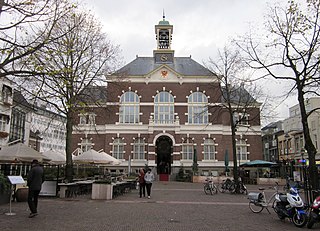
Apeldoorn is a municipality and city in the province of Gelderland in the centre of the Netherlands. It is a regional centre. The municipality of Apeldoorn, including villages like Beekbergen, Loenen, Ugchelen and Hoenderloo, had a population of 162,445 in 2019. The western half of the municipality lies on the Veluwe ridge, the eastern half lies in the IJssel valley.

Putten is a municipality and town in the province of Gelderland, Netherlands. It had a population of 24,198 in 2019. It is located in the coastal area of the old Zuiderzee. To the east of Putten lies the Veluwe, the biggest national park of the Netherlands. To the north, east and west, Putten is surrounded by farmlands.

Scherpenzeel is a municipality and a town in the Dutch province of Gelderland. As of 2019, it has a population of 9,873, with approximately 6,000 adults. The community of Scherpenzeel also contains a part of the hamlet of Moorst.

The Veluwe is a forest-rich ridge of hills (1100 km2) in the province of Gelderland in the Netherlands. The Veluwe features many different landscapes, including woodland, heath, some small lakes and Europe's largest sand drifts.
West-Veluws is a Veluws dialect from the Dutch province of Gelderland. This dialect is spoken in different villages on the west side of the Veluwe and some villages on border of Gelderland and Utrecht. Sometimes even the dialect of Huizen in North Holland is seen as West-Veluws.
Veluws is a Dutch Low Saxon dialect which is spoken on the Veluwe. The language was recognized by the government of the Netherlands in 1996.

Vijfheerenlanden, literally "lands of five Lords", is a municipality in the province of Utrecht in the Netherlands. The municipality was created on 1 January 2019 through the merger of the former municipalities of Vianen (Utrecht), Leerdam and Zederik.

Apeldoorn railway station is a railway station in Apeldoorn in Gelderland, Netherlands. The station was opened on 15 May 1876, on the Amsterdam–Zutphen railway. It was opened when the Amersfoort to Zutphen section was completed. Journey time to Amsterdam is 1 hour, as of the 2017 timetable.
Hard and soft G in Dutch refers to a phonological phenomenon of the pronunciation of the letters ⟨g⟩ and ⟨ch⟩ and also a major isogloss within that language.
Oost-Veluws is one of the main dialects of Veluws and is therefore related to West-Veluws and Sallaans. It is spoken in the Dutch province Gelderland. However, it is quite rare to come across a native speaker of "Oost-Veluws", as few people actually still speak this dialect.
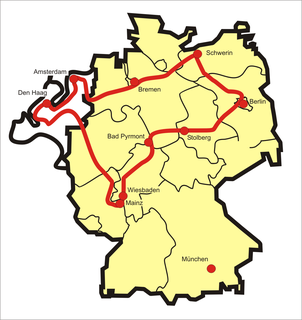
The Orange Route is a holiday route, that runs from Amsterdam in the Netherlands through North and Central Germany and returns to Amsterdam. It is 2,400 kilometres long and crosses the Netherlands and nine of German federated states. The Orange Route runs through towns and regions that linked the House of Orange-Nassau for centuries.
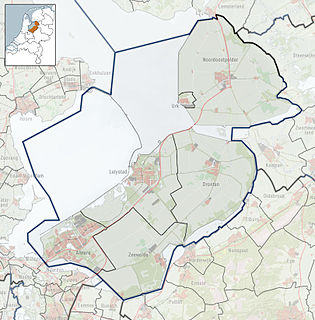
In the Netherlands, the bordering lakes are a chain of lakes which separate the Flevopolder from the ancient lands of the provinces of Gelderland and Utrecht and the Noordoostpolder.

Radio Gelderland is a regional public radio station for the Dutch province of Gelderland. Its history started in 1965 when Gelderland joined the RONO. The RONO was already broadcasting for the north and east of the Netherlands. In 1977 RONO split into Radio Noord for Groningen and Drenthe, Radio Fryslân for Friesland and Radio Oost for Overijssel and Gelderland. Since 1985 Radio Gelderland is an independent broadcaster.

The Wolderwijd is a bordering lake situated in the Netherlands, created in 1967 by the gaining of land in Southern Flevoland. It is one of four Veluwe bordering lakes. On the northern and western bank it is encompassed by the municipality of Zeewolde, in the Province of Flevoland, and on the southern and eastern bank it is encompassed by the municipality of Harderwijk in the Province of Gelderland. As the bordering lakes of Flevoland are strictly speaking one mass of water there are no exact markers on where the Wolderwijd ends and the adjacent lakes start. In the west near Strand Horst the Wolderwijd becomes the Nuldernauw and in the east at the aqueduct at the provincial road N302 it becomes the Veluwemeer.
